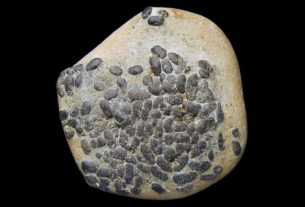Disappeared in the early 1700s in the North Atlantic, the gray whale is particularly discreet in the fossil archives, hence the interest of this study. A team of scientists describes the discovery of an almost complete specimen wrongly identified as a humpback whale thirty years ago.
The gray whale (Eschrichtius robustus) is a cetacean species found in the Pacific. It is often seen along the west coast of North America, from Alaska to Mexico. In the Atlantic, however, these mammals are unfortunately only a memory. Disappeared more than three hundred years ago, they are only mentioned in a few historical documents or simply evoked by the occasional discovery, here and there, of a single bone. This is why this news is important.
A team of biologists announces that they have identified the most complete North Atlantic gray whale skeleton ever discovered. In reality, this skeleton had been discovered in the 70s, washed up on a beach in North Carolina (United States). However, until recently we thought it was the remains of a humpback whale. The specimen now resides in the Smithsonian National Museum of Natural History.
Over 800 years
The skeleton is that of a nine-meter-long juvenile. It includes forty-two cranial and post-cranial elements, parts of the rostrum, the two mandibles, the shoulder blades, the humeri, the rays and the ulnae, most of the vertebral column anterior to the lumbar region, and numerous ribs. Such a discovery is exceptional. Since these whales live on the high seas, their remains usually sink to the bottom of the water, if they are not devoured first. Only a few unique bones have thus been found washed up on the beaches.
Radiocarbon dating performed on one of the samples suggests that this whale died 827 years ago. His remains were discovered near the entrance to a large estuary that could have been used as a breeding and calving area similar to those favored by gray whales living off Baja California.
The remains also suggest the whale was stranded in ancient, partially submerged sediment lying on its right side. Later, as the region’s barrier islands shifted, his body was fully buried and preserved. A more detailed analysis of its skeleton will allow biologists to make size and shape comparisons with other whale populations and other genetic analyses, potentially shedding new light on the species or its evolutionary history.
We also know that some bones of this whale were “worked” by indigenous locals at the time. The latter probably used the sharp stone axes to skin the animal. The authors believe that this action was probably opportunistic. However, it is also possible that these natives ventured out to sea in boats to kill the animal or drive it into shallow waters.
A possible return?
Genetics suggest that gray whales entered the Atlantic before the last ice age, 130,000 to 115,000 years ago, if not even before. We believe that whalers completed them in the early 1700s. However, patterns of genetic diversity over time suggest that their decline began long before, likely due to changing oceanographic regimes during the Holocene.
Genetic data also shows us that Atlantic gray whales are directly descended from populations in the North Pacific. However, their populations have never been as large as those in the Pacific. This could be because the Atlantic offered fewer coastal shelf habitats, and therefore fewer potential foraging areas.
However, melting Arctic sea ice may one day give gray whales the opportunity to adapt again. If this is the case, these animals will nevertheless have to confront a very different ocean from that of three centuries ago. Ship traffic, fishing lines and other resource extraction infrastructure have indeed made this coastal habitat much more dangerous and noisy. Warmer, more acidic waters have also reduced the populations of invertebrates that these whales love so much.




